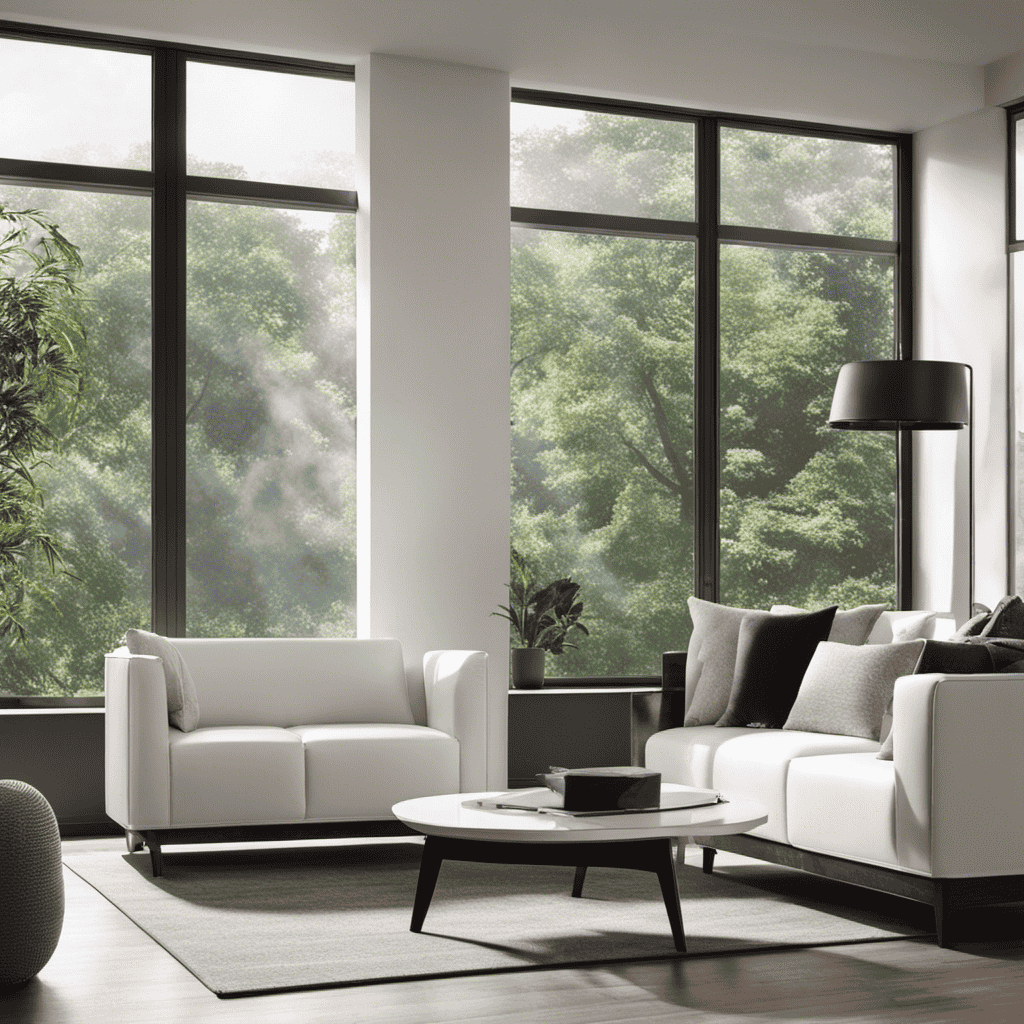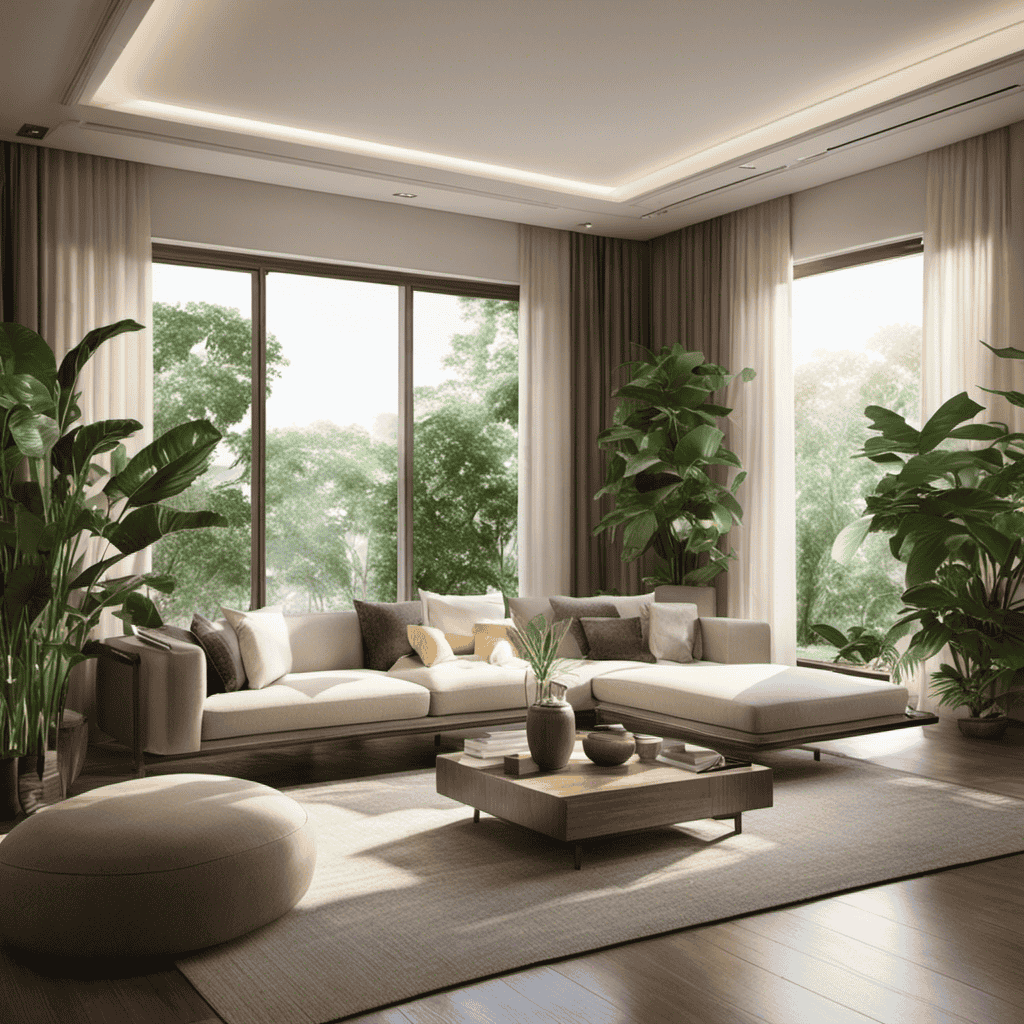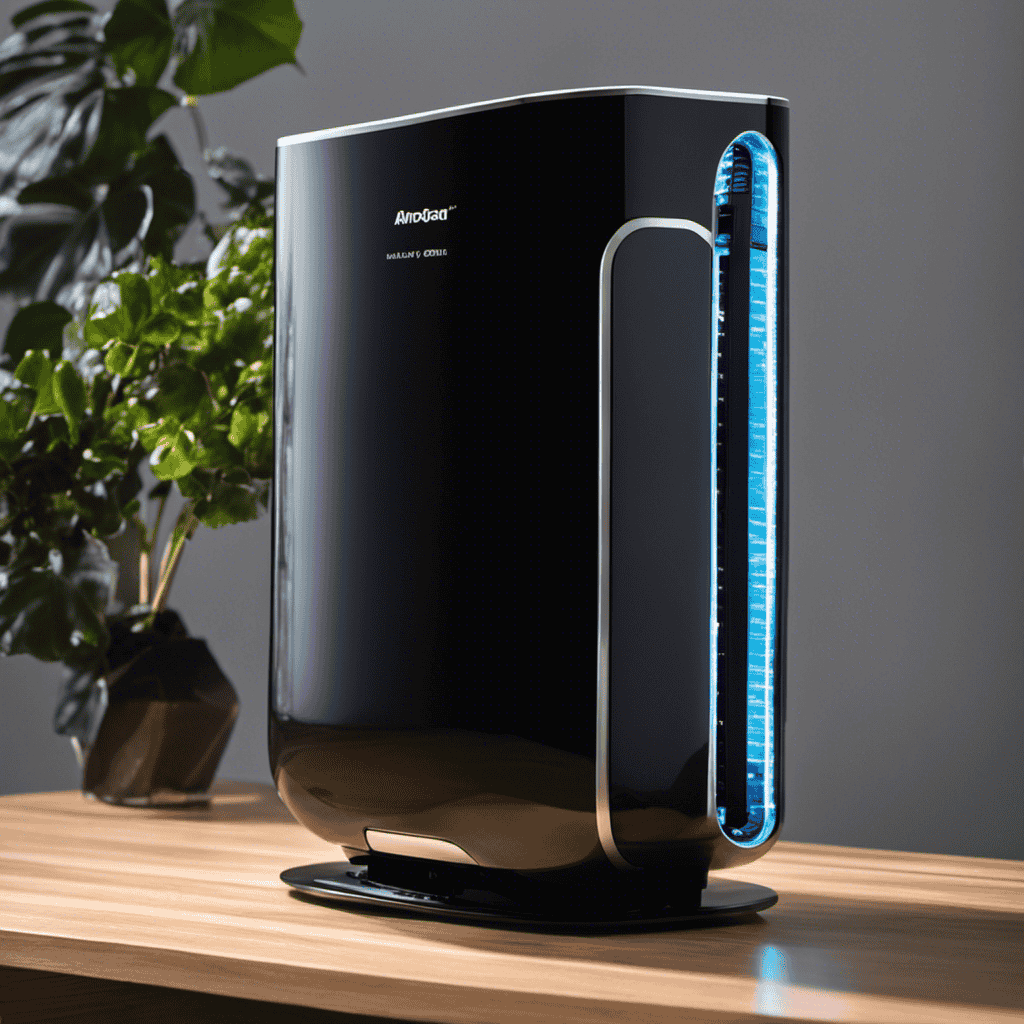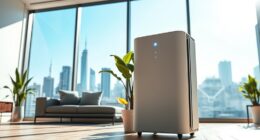I understand your concern – with the abundance of air purifiers available, how can you select the best one for dealing with smoke? Don’t worry, because I am here to help you navigate the selection process.
In this article, we’ll explore the different types of air purifiers, key factors to consider, and the importance of HEPA and activated carbon filters.
We’ll also delve into ionizers and ozone generators, as well as additional features to look for.
By the end, you’ll be equipped to make an informed decision and breathe cleaner air in no time.
Key Takeaways
- Consider whether you want a HEPA filter or an activated carbon filter
- HEPA filters are effective at removing small particles like dust, pollen, and pet dander
- Activated carbon filters are great for removing odors, chemicals, and gases
- Portable purifiers with HEPA or activated carbon filters are suitable for specific rooms or areas
Types of Air Purifiers
When it comes to types of air purifiers, you should consider whether you want a HEPA filter or an activated carbon filter. HEPA filters are great for removing small particles like dust, pollen, and pet dander from the air. They work by trapping these particles in a dense filter.
On the other hand, activated carbon filters are effective at removing odors, chemicals, and gases from the air. They work by adsorbing these pollutants onto the surface of the carbon.
If you only need to purify the air in a specific room or area, portable purifiers with HEPA or activated carbon filters are a good option. They are small and easy to move around.
However, if you want to purify the air in your entire house, whole house purifiers are the way to go. These purifiers are installed in your HVAC system and treat the air in every room. They are more expensive but offer comprehensive air purification.
Factors to Consider
To choose the right air purifier for smoke, you’ll need to consider factors like size, filtration technology, and noise level. Here are the factors to prioritize and some budget considerations:
-
Size: Determine the size of the room or area where you plan to use the air purifier. This will help you choose the appropriate size and capacity for effective smoke removal.
-
Filtration Technology: Look for air purifiers with high-efficiency particulate air (HEPA) filters. These filters are designed to capture smoke particles and other pollutants effectively.
-
Noise Level: Consider the noise level of the air purifier. Some models can be quite noisy, which can be disruptive in a quiet environment like a bedroom or office.
-
Budget Considerations: Set a budget for your air purifier purchase. While there are expensive options with advanced features, there are also affordable models that offer excellent smoke removal capabilities.
HEPA Filters
When it comes to filtering smoke particles and improving air quality, choosing the right air purifier model is essential. HEPA filters are highly effective at capturing smoke particles and other pollutants, making them a popular choice for homeowners.
Filtering Smoke Particles
If you want to filter smoke particles effectively, you should consider buying an air purifier with a HEPA filter. These filters are designed to capture even the smallest particles, including smoke, ensuring cleaner and healthier air in your home.
Here are four reasons why investing in a HEPA air purifier is crucial when it comes to smoke removal techniques and protecting yourself from the health risks of smoke inhalation:
-
Superior filtration: HEPA filters can remove up to 99.97% of smoke particles as small as 0.3 microns, reducing the amount of harmful substances you breathe in.
-
Odor elimination: Along with capturing smoke particles, HEPA filters also help to eliminate unpleasant odors associated with smoke, leaving your space smelling fresh.
-
Allergen reduction: HEPA filters are highly effective in trapping allergens, such as pollen and dust mites, providing relief for those with respiratory conditions exacerbated by smoke.
-
Peace of mind: With a HEPA air purifier, you can have peace of mind knowing that you are taking proactive steps to protect your health and well-being in the face of smoke exposure.
Air Quality Improvement
Improving the quality of your indoor environment is essential for your health and well-being. When it comes to air purifiers, regular maintenance is key to ensure they continue to effectively filter out pollutants and allergens.
To keep your air purifier running efficiently, it is important to clean or replace the filters regularly. This will help to maintain the air quality in your home and prevent any buildup of contaminants.
Additionally, there are cost-effective options available for air purifier maintenance. Some air purifiers come with washable filters, which can save you money in the long run. Another cost-effective option is to purchase air purifiers with high-quality filters that have a longer lifespan.
Choosing the Right Model
To find the right air purifier for you, consider factors such as room size, filter type, noise level, and budget. There are countless options available from various brands, so it’s important to make an informed decision.
Here are four key considerations to keep in mind:
-
Room size: Ensure that the air purifier you choose is suitable for the size of the room you plan to use it in. A purifier designed for small spaces may not effectively clean the air in a larger room.
-
Filter type: Different purifiers use different types of filters, such as HEPA filters or activated carbon filters. Consider your specific needs and choose a model that effectively removes the pollutants you are concerned about.
-
Noise level: Some air purifiers can be quite noisy, which can be bothersome if you plan to use it in a bedroom or office. Look for models with a noise level that suits your preferences.
-
Budget considerations: Set a budget for your air purifier purchase and explore options within that range. Consider not only the initial cost but also ongoing expenses for filter replacements.
Activated Carbon Filters
Activated carbon filters are effective at removing smoke particles and odors from the air. These filters work by adsorbing the smoke particles onto the surface of the carbon. Compared to electrostatic precipitators, which use an electric charge to attract and trap particles, activated carbon filters are more efficient at capturing smoke particles. They are also capable of eliminating odors, making them a popular choice for smoke removal.
One advantage of activated carbon filters is their low maintenance. They typically only require periodic replacement, depending on the manufacturer’s recommendations and the level of smoke exposure. The lifespan of activated carbon filters can vary, but on average, they last around 3 to 6 months. It’s important to regularly check the filter and replace it when it becomes saturated to ensure optimal performance.
Transition: Now that we have covered activated carbon filters, let’s move on to the next type of air purifier: ionizers and ozone generators.
Ionizers and Ozone Generators
After learning about activated carbon filters, let’s now explore ionizers and ozone generators, two other types of air purifiers commonly used to combat smoke.
Ionizers work by emitting negatively charged ions into the air, which attach to positively charged particles like smoke and allergens, causing them to clump together and fall to the ground.
Ozone generators, on the other hand, release ozone into the air, which is intended to remove odors and kill bacteria. However, it’s important to note that ozone generators can be harmful to our health. Here are four reasons to be cautious:
- Ozone can irritate the lungs and worsen respiratory conditions.
- Long-term exposure to ozone can lead to lung damage.
- Ozone can react with other substances in the air, creating harmful byproducts.
- Ozone generators may not effectively remove smoke particles from the air.
Considering the potential health risks associated with ozone generators, it’s crucial to prioritize safety and opt for alternative air purifiers.
Now, let’s explore additional features to look for when choosing an air purifier.
Additional Features to Look for
When choosing an air purifier, you’ll want to consider the different additional features available.
One important feature to look for is smart technology. With smart technology, you can control and monitor your air purifier from your smartphone or other devices. This allows for convenient and easy operation, even when you’re not at home.
Another feature to consider is the noise level. Air purifiers can sometimes be noisy, especially if they have a high fan speed. Look for models that have a low noise level, so you can enjoy clean air without the distraction of loud sounds.
Frequently Asked Questions
Are There Any Air Purifiers Specifically Designed for Removing Smoke Particles From the Air?
There are air purifiers specifically designed to remove smoke particles from the air. Some of the best air purifier brands for smoke removal include Honeywell, Blueair, and Coway. These top-rated air purifiers use advanced filtration systems to effectively eliminate smoke particles.
How Often Do I Need to Replace the Filters in an Air Purifier?
Filters in air purifiers last for different durations depending on the model and usage. It is recommended to replace them every 3-6 months for optimal performance. Not all purifiers come with replaceable filters, so it’s important to check before purchasing.
Can Air Purifiers Completely Eliminate the Smell of Smoke From My Home?
Air purifiers can effectively reduce the smell of smoke in your home, but it’s important to note that they may not completely eliminate it. Common misconceptions often lead to unrealistic expectations.
Are There Any Health Risks Associated With Using Ionizers or Ozone Generators in Air Purifiers?
Using air purifiers with ionizers or ozone generators may pose health risks. It’s important to be cautious and informed before incorporating them into your home. Consult experts and consider alternative options for clean air.
Can Air Purifiers Effectively Remove Smoke Particles From Large Open Spaces, Such as Living Rooms or Open-Plan Offices?
Air purifiers are effective in removing smoke particles from large open spaces. Different brands vary in efficiency, so research which ones have the highest smoke particle removal rates before making a purchase decision.
Conclusion
After considering all the factors, I finally found the perfect air purifier for smoke.
With its HEPA and activated carbon filters, it will effectively remove smoke particles and odors from the air.
Plus, its ionizer feature will freshen up the atmosphere, leaving it crisp and clean.
I can’t wait to experience the difference it will make in my home.
Stay tuned for the surprising impact it will have on my health and well-being.










